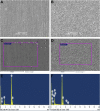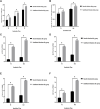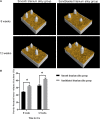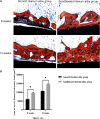Manufacture of titanium alloy materials with bioactive sandblasted surfaces and evaluation of osseointegration properties
- PMID: 37671189
- PMCID: PMC10475539
- DOI: 10.3389/fbioe.2023.1251947
Manufacture of titanium alloy materials with bioactive sandblasted surfaces and evaluation of osseointegration properties
Abstract
Titanium alloys are some of the most important orthopedic implant materials currently available. However, their lack of bioactivity and osteoinductivity limits their osseointegration properties, resulting in suboptimal osseointegration between titanium alloy materials and bone interfaces. In this study, we used a novel sandblasting surface modification process to manufacture titanium alloy materials with bioactive sandblasted surfaces and systematically characterized their surface morphology and physicochemical properties. We also analyzed and evaluated the osseointegration between titanium alloy materials with bioactive sandblasted surfaces and bone interfaces by in vitro experiments with co-culture of osteoblasts and in vivo experiments with a rabbit model. In our in vitro experiments, the proliferation, differentiation, and mineralization of the osteoblasts on the surfaces of the materials with bioactive sandblasted surfaces were better than those in the control group. In addition, our in vivo experiments showed that the titanium alloy materials with bioactive sandblasted surfaces were able to promote the growth of trabecular bone on their surfaces compared to controls. These results indicate that the novel titanium alloy material with bioactive sandblasted surface has satisfactory bioactivity and osteoinductivity and exhibit good osseointegration properties, resulting in improved osseointegration between the material and bone interface. This work lays a foundation for subsequent clinical application research into titanium alloy materials with bioactive sandblasted surfaces.
Keywords: bioactive sandblasted surface; biomaterial; osseointegration; surface modification; titanium alloy.
Copyright © 2023 Wang, Yang, Guo, Yu and Li.
Conflict of interest statement
The authors declare that the research was conducted in the absence of any commercial or financial relationships that could be construed as a potential conflict of interest.
Figures












Similar articles
-
Characterization and evaluation of a femtosecond laser-induced osseointegration and an anti-inflammatory structure generated on a titanium alloy.Regen Biomater. 2021 Mar 13;8(2):rbab006. doi: 10.1093/rb/rbab006. eCollection 2021 Mar. Regen Biomater. 2021. PMID: 33738120 Free PMC article.
-
Nano-scale modification of titanium implant surfaces to enhance osseointegration.Acta Biomater. 2019 Aug;94:112-131. doi: 10.1016/j.actbio.2019.05.045. Epub 2019 May 22. Acta Biomater. 2019. PMID: 31128320 Review.
-
Bioprinting of Cell-Laden Hydrogels onto Titanium Alloy Surfaces to Produce a Bioactive Interface.Macromol Biosci. 2022 Jun;22(6):e2200071. doi: 10.1002/mabi.202200071. Epub 2022 Apr 11. Macromol Biosci. 2022. PMID: 35365963
-
Enhanced Osseointegration of Titanium Alloy Implants with Laser Microgrooved Surfaces and Graphene Oxide Coating.ACS Appl Mater Interfaces. 2019 Oct 30;11(43):39470-39483. doi: 10.1021/acsami.9b12733. Epub 2019 Oct 17. ACS Appl Mater Interfaces. 2019. PMID: 31594306
-
Osseointegration of titanium, titanium alloy and zirconia dental implants: current knowledge and open questions.Periodontol 2000. 2017 Feb;73(1):22-40. doi: 10.1111/prd.12179. Periodontol 2000. 2017. PMID: 28000277 Review.
Cited by
-
Construction of functional surfaces for dental implants to enhance osseointegration.Front Bioeng Biotechnol. 2023 Nov 14;11:1320307. doi: 10.3389/fbioe.2023.1320307. eCollection 2023. Front Bioeng Biotechnol. 2023. PMID: 38033823 Free PMC article. Review.
-
Effect of Ti6Al4V Alloy Surface and Porosity on Bone Osseointegration: In Vivo Pilot Study in Rabbits.Materials (Basel). 2025 May 6;18(9):2141. doi: 10.3390/ma18092141. Materials (Basel). 2025. PMID: 40363646 Free PMC article.
References
LinkOut - more resources
Full Text Sources

